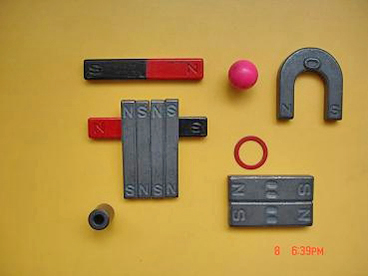Permanent Ferrite
A compound with a uniaxially anisotropic hexagonal structure. Mainly are barium, strontium, lead three kinds of ferrite and its composite solid solution. There are same-sex magnetism and opposite-sex magnetism. Since this type of ferrite material can still retain a strong constant remanence for a long time after the external magnetization field disappears, it can be used to generate a constant magnetic field in the external space. It has a wide range of applications, such as: in various meters, generators, telephones, speakers, televisions and microwave devices as a constant
Magnet is used.
Hard Magnetic Materials
Ferrite
hard magnetic material is not easy to demagnetize after magnetization, so it is also called
Permanent Magnetic Materials or Permanent Magnetic Materials. Such as barium ferrite, steel oxide, etc. It is mainly used in recorders, pickups, speakers, magnetic cores of various instruments, etc. in telecommunication devices.
Gyromagnetic material
The gyromagnetism of magnetic materials refers to the phenomenon that the plane-polarized electromagnetic wave propagates in a certain direction inside the material under the action of two mutually perpendicular steady and constant magnetic fields and electromagnetic wave magnetic fields, but its polarization plane will continuously rotate around the propagation direction. Although metal and alloy materials also have certain gyromagnetic properties, they cannot be used due to low resistivity and too large eddy current loss, and electromagnetic waves cannot penetrate into their interiors. Therefore, the application of gyromagnetism of ferrite gyromagnetic materials has become a unique field of ferrite. Most of the gyromagnetic materials are combined with waveguides or transmission lines that transport microwaves to form various microwave devices. Mainly used in radar, communication, navigation, telemetry and other electronic equipment.
Torque Magnetic Materials
This refers to ferrite materials with rectangular hysteresis loops. Its characteristic is that when there is a small external magnetic field, it can be magnetized and reach saturation. After removing the external magnetic field, the magnetism remains the same as when it is saturated. Such as magnesium manganese ferrite,
lithium manganese ferrite and so on. This ferrite material is mainly used in memory cores and other aspects of various electronic computers.
piezomagnetic material
This type of material refers to ferrite materials that are mechanically elongated or shortened in the direction of the magnetic field when magnetized, such as nickel-zinc ferrite, nickel-copper ferrite, and nickel-chromium ferrite. Piezomagnetic materials are mainly used as transducers for the mutual conversion of electromagnetic energy and mechanical energy, as
magnetostrictive a> The element is used for ultrasound.
Application ScopeEdit
Scope
Magnetic materials are widely used in electro-acoustics, telecommunications, electricity meters, motors, and can also be used as memory components, microwave components, etc.
tape that can be used to record language, music, image information, magnetic storage devices for computers, passengers The voucher for the ride and the
magnetic card for the fare settlement, etc. The following focuses on the magnetic materials used on the magnetic tape and the principle of action.
Principle
After
hard magnetic material is magnetized, there is still residual magnetism. The direction depends on the strength and direction of the magnetism at the time of magnetization. The audio tape is composed of a tape base, an adhesive and a
magnetic powder layer. The tape base is generally made of polycarbonate or vinyl chloride. Magnetic powder is r-Fe2O3 or CrO2 fine powder with remanence. When recording, the current corresponding to the sound change is amplified and sent to the coil of the recording head, so that a concentrated magnetic field is generated in the gap of the iron core of the head. As the coil current changes, the direction and strength of the magnetic field also changes accordingly. When the tape passes through the head gap at a constant speed, the magnetic field passes through the tape and magnetizes it. Since the magnetic tape leaves the magnetic head with corresponding residual magnetism, its polarity and intensity correspond to the original sound. The tape is constantly moving, and the sound is constantly being recorded on the tape.
When playing, feed the recorded tape close to the gap of the playback head at the same speed as when recording. The head core is made of high
magnetic permeability ferrite soft magnetic material, it The resistance to magnetic flux is very small. Therefore, the audio residual magnetic flux recorded on the magnetic tape is easy to form a loop through the magnetic head iron core. The residual magnetic flux on the magnetic tape induces an induced electromotive force on the playback head coil that has the same changing law as the residual magnetic flux. After being amplified by the playback amplifier, it is sent to push the speaker, and the audio signal recorded on the tape will be restored to the original sound.
Function
video tapes are basically the same materials and working principles as audio tapes, but the recordings are The electrical signal represents the sound, while the video records the television signal that represents the scenery. There are not only sound signals but also image signals in the TV signal. Compared with audio tapes, the recording density of video tapes is very high, because the recording wavelength of video tapes is in the order of micrometers. In order to have sufficient sensitivity and signal-to-noise ratio in this wavelength range, the particle size of the magnetic body must be small,
magnetic layer surface must be smooth. Moreover, the wear resistance of the surface of the magnetic layer must be good, so that it can be used under the conditions of high-speed friction with the magnetic head and friction with the fixed part of the conveying system of the magnetic tape. For this, the adhesives used must be heat-resistant and wear-resistant.
4. Computer Magnetic Storage Devices
The magnetic materials and working principles used in computer magnetic storage devices and magnetic cards used as passenger vouchers and fare settlement are basically the same as the magnetic materials and working principles used in magnetic tapes, but their uses are different. There is a narrow tape on the magnetic card. When you take the subway from station A to station B, put the ticket money (coin) from station A to station B into the instrument at station A, and then throw out a magnetic card, at In the process of throwing out this magnetic card, the magnetic record of getting off at Station B has been recorded. Take this magnetic card and take the bus to Station B and put it into the instrument, the door will open, and you will exit the station. If you don't get off at Station B, but get off at Station C, which is farther than Station B, you will not have enough coins and the exit door will not open. You need to get a magnetic card to make up the ticket before you can leave the station.
The process of putting in the magnetic card at station B or station C is the process in which the magnetic recording is turned into an electrical signal through the magnetic head. Then use the electric signal to control the station door switch.
The magnetic material used in the iron core of the motor is generally
hard ferrite. The characteristics of these materials are It is not easy to demagnetize after magnetization. Low resistance to magnetic flux.
Production processEdit
According to the crystal structure and morphology of ferrite, the preparation process is roughly divided into: polycrystalline ferrite production process;Ferrite chemical process; single crystal ferrite manufacturing process and other special processes, such as ferrite polycrystalline thin film and amorphous ferrite, etc.
[1]
Polycrystalline ferrite production process
Similar to the sintering process commonly used in the ceramic industry, it includes the following steps: metal oxides or carbonates or other compounds that form ferrite through solid-phase reaction, after mixing uniformly, ball milling, drying, and pressing into a specific shape. After pre-firing at a temperature of about 1000°C, it is again thoroughly ground and mixed. Add an appropriate amount of binder and press into the desired shape or extrude into a tube, rod or strip as a plastic mass. It is then sintered at 1200-1400°C, the exact temperature depending on the desired ferrite properties. During the final sintering process, the environmental conditions in the furnace play an important role.
Ferrite Chemical Process
Also known as wet process and sometimes chemical co-precipitation. The process method for preparing high-performance ferrite can be divided into neutralization method and oxidation method. The process is: first, the metal elements required for the preparation of ferrite are prepared into an ionic solution of a certain concentration, and then an appropriate amount of solution is mixed according to the formula, and ferrite powder is generated through chemical reactions such as neutralization or oxidation. The process is the same as described earlier.
Single crystal ferrite manufacturing process
About the same as non-metal single crystal growth. The growth of Mn-Zn and Ni-Zn ferrite single crystals is generally carried out by the Britzmann method, that is, after the polycrystalline ferrite is melted in a platinum crucible, the crucible is lowered in a suitable temperature gradient electric furnace, from The bottom of the crucible slowly solidifies to form a single crystal. In order to balance the oxygen partial pressure formed in the molten state, an oxygen partial pressure of several or even 100 MPa needs to be added to the furnace during crystal growth.
Preparation of ferrite polycrystalline films
For example, perpendicularly magnetized barium ferrite films are sputtered by a new type of counter-target sputtering device. The preparation of garnet single crystal thin films is mostly carried out by gas phase or liquid phase epitaxy on a single crystal substrate, and the specific process is very similar to the epitaxy method of semiconductor single crystal thin films.
Preparation of amorphous ferrite
At present, the super-quick cooling method and sputtering method are adopted. The so-called super-quick cooling method is a method of suddenly performing super-quick cooling with a large temperature gradient after mixing a ferrite raw material with an appropriate amount of metalloid elements in a high-temperature molten state. The research work in this area has just started, and the performance of the product is not yet ideal.





